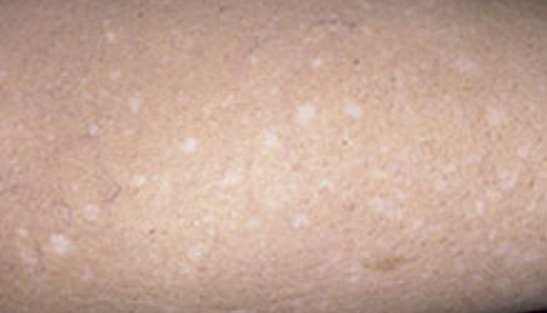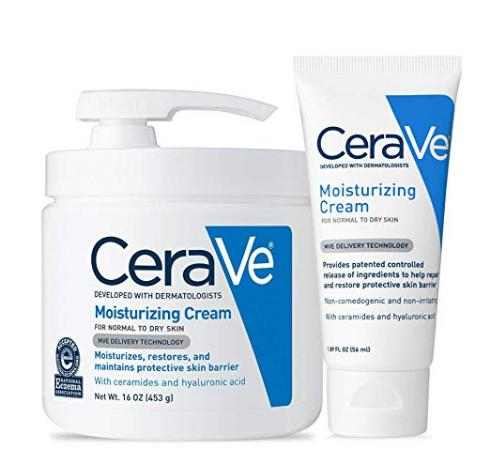When the color of the skin changes in any way, it is often due to an underlying condition that may or may not need to be treated.
White spots on the legs or the rest of the body are a not-so-rare occurrence that requires identification of the cause and then seeking treatment. If you have noticed any depigmentation or white spots, here is all there is to know.
What are small white spots?
Tiny or small white spots occur as white patches on the skin or scattered spots. They are often flush with the skin (not filled with fluid or swollen). These spots and patches can occur anywhere on the body, including the legs, the hands, the back, and even the face.
Depending on the cause of these spots, they may be itchy or exhibit other such symptoms, all of which will tell your dermatologist what to do.
Pictures
Here are pictures to help you identify the appearance of different small white dots on your legs.
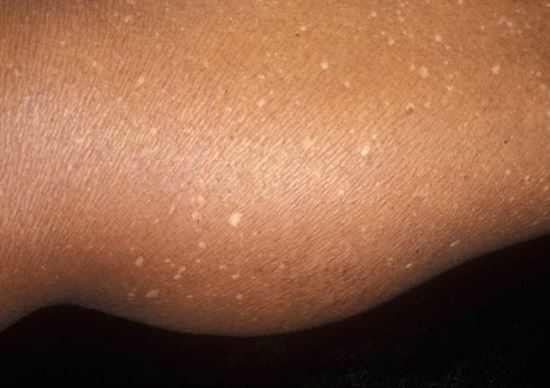
Symptoms
The symptoms of each kind of spot will depend on their actual cause. However, the general symptom is the presence of areas or spots without color compared to the rest of the body.
The causes of white patches on legs
There is a myriad of causes for the white spots you may have on your skin. The actual cause of these spots will determine the treatment method and how long they will be under treatment. The causes include:
Pityriasis alba
This disease begins with slightly small scaly plaques that are pink in color and found on the cheeks and the chin. These plaques have different shapes, including being irregular, oval, or round. When touched, the plaques are scaly and dry.
At times, the plaques will go away on their own, or they will slowly fade away to pave the way for white patches.
Pityriasis alba is common among children and teenagers and those with dark skin. This disease has a medical relationship with eczema.
Treating pityriasis alba
This disease often goes away on its own and hence not so serious of an issue. However, doing away with the white patches requires various medications such as:
- Nonsteroidal creams
- Topical steroid
- Moisturizing creams. Our favorite is the one from CeraVe (Check price on Amazon)
Before using any medicine or home remedy on your body, always make it a priority to consult your doctor for the correct diagnosis and whether it is safe to use them or not.
Vitiligo
The color of your skin is determined by how much melanin your body produces. Without melanin, you will have white patches of skin. The melanin pigment is produced by the melanocytes cells.
When the melanocytes fail to produce melanin, you will have white patches on your skin, eye, and even hair. The patches will appear on any part of the body.
Vitiligo is set aside by the other causes of small white spots since it is often symmetric in the way it affects the body in that it affects both sides of the body on equal measure. It can, however, affect only one side of the body.
Among the areas to be affected by vitiligo include the hair, genitals, hands, and knees.
The causes of vitiligo are currently not known. On the list of the most likely causes are genetic causes and hyperthyroidism, among other autoimmune diseases.
Treating vitiligo
Vitiligo treatment methods are focused on the restoration of color to the affected areas. Among the methods available include:
- Immunomodulators
- Steroids
- Ultraviolet light therapy
- Cover-up makeup
- Surgery
Surgery is only to be used in the most severe cases. Otherwise, the other methods are effective on their own.
Tinea versicolor
These are spots on the skin, which can be of different colors, including brown, red, pink, or white. They are easy to notice when the skin is tanned.
With time, they may become larger and more noticeable. Often, the patches may be itchy, scaly, and dry.
Tinea versicolor is caused by the overgrowth of yeast on the skin. The overgrowth may be caused by various issues, including:
- Having oily skin
- A weak immune system
- Sweating excessively
- Warm and humid conditions
This disease is most common in people who live in tropical climates. However, anyone can get the disease no matter their ethnic belonging. Due to having skin with more oil than others, teenagers are more susceptible to this condition.
Treating tinea versicolor
Often, those with this disease will experience an increase in symptoms when they get to warm weather and their recession in cooler weather. If treated early enough, however, their recurrence will go away in totality.
The good news is that, if you catch it early enough, tinea versicolor can be easily treated with over the counter antifungal medicine such as:
- Selenium sulfide
- Clotrimazole
- Miconazole
- Ketoconazole, and many others.
The time taken by tinea versicolor to heal depends on how advanced the disease is. It may take several weeks to heal and some more to restore your skin to its original appearance.
Advanced cases of this disease may require stronger medication such as creams and oral medication. If the disease recurs, you will have to repeat the treatment.
Lichen sclerosis
This is a rare skin condition mostly found in the young and the old. While it can affect most areas of the body, lichen sclerosis is common around the vulva and anus in women and on the foreskin of the penis in men.
Although the actual cause of this disease is not yet known, a hyperactive immune system or hormonal imbalances are the suspects.
Among the symptoms of lichen sclerosis are:
- Severe itching in affected areas
- Pain during sexual intercourse
- You may have skin that tears or bruises with ease
- Difficulties in urinating
- Blisters
- Bleeding randomly
Lichen sclerosis may not even have symptoms in its mild form.
Treating lichen sclerosis
The available treatment methods for this disease focus on reducing the itching and the scarring while eliminating any further thinning of the skin. The same methods help improve the appearance of the skin and include creams and corticosteroids.
Idiopathic guttate hypomelanosis (IGH)
Idiopathic guttate hypomelanosis (IGH) is often referred to as sunspots since they occur on patches of skin that have received a high amount of exposure to the sun. The legs and the arms are among the most likely places to have sunspots.
Unlike other types of white spots, sunspots are benign (inactive) and have no pain at all.
You are likely to have IGH if you have light skin and are a woman of a young age. While it also affects men, the chances are lower in men than in women. Older women above 40 are also at the risk of getting the condition.
Treatment
You can prevent and reduce further damage to the skin by limiting the number of hours you have exposure to the sun to just a few and using sunscreen. Besides preventing further skin damage, sunscreen can help prevent many other conditions, including skin cancer.
Once the spots have appeared, it is difficult getting rid of them unless you consider the following options:
- Laser treatments
- Calcineurin inhibitors.
- Cryotherapy/cryosurgery/cold therapy
- Phototherapy
- Microdermabrasion/dermabrasion
- Skin grafting
- Topical steroids
- Chemical peels like trichloroacetic acid (TCA) peels and carbolic acid (phenol) peels
- Camouflage makeup
- Retinoids like tretinoin cream
Home remedies for IGH
While there are medicines you can use for this disease, you can use the following remedies at home with this condition:
- Walnuts and figs
While figs are packed with antioxidants that fight the effects of free radicals, walnuts have both antifungal and anti-aging ingredients. The two, when consumed regularly, will help the skin regain its natural look by promoting regeneration and elasticity. They also promote blood circulation in the skin cells.
- Fresh ginger
When you mix fresh ginger with lemon juice and apply the mixture to the affected area, it will help increase the flow of blood to the area. This will help restore pigmentation in the area.
- Lime and basil
You can stimulate the production of melanin by adding basil extract to some lime juice then applying it to the affected area.
- Fresh cabbage juice
Besides their many nutrients, cabbages have a major benefit when treating IGH. Simply apply the fresh juice to your skin or drink it fresh for the best results.
Your doctor will also tell you about other routines and items to consider.
Eczema
Also called atopic dermatitis, eczema often causes red rashes that are raised and itchy. At times, the rashes may have white patches or spots. Eczema affects various parts of the body including the scalp, the face, the hands, the elbows, the feet, the eyelids, the back of the knees and the wrists.
The rashes caused by eczema often have the itch whose intensity goes up at night. Intense scratching can lead to sores that are open and leak fluid. With time, the affected patches of skin may turn to be scaly, dry, and thickened.
The one trait that is synonymous with eczema rashes is that they randomly flare up then recede without any specific reason. The length of a flare-up or recession can vary from a few days to years at times.
This disease affects people of all ages and often starts before the age of five. If you have some allergies, you are at a higher risk of having the disease than someone who of free of allergies. Allergies like hay fever are the most common culprits of eczema.
Treating eczema
While there is no way to completely eradicate eczema from the body, you can manage the symptoms to keep its symptoms under control. The routines to use include the following:
- You should use medicated creams in treating the rash.
- Keep the time spent taking a shower to the minimal, and keep off hot showers as both may irritate the skin and flare up the symptoms.
- When using solvents for your skin, limit your options to natural ones. Chemical solvents often worsen the symptoms.
- Any form of air pollution, including smoke from cigarettes, can flare up the condition hence should be avoided as much as you can.
- Ensure the cleansers you use for your skin are mild to avoid making the symptoms worse.
- Keep your skin from drying up by use skin moisturizers at all times.
- When handling cleaning solvents, make it a habit using gloves.
- Allergens such as hay fever should be managed by avoiding as much of the allergens as you can.
- When the itching sets in, you may use an oral allergy medicine such as an antihistamine, or anti-itch creams.
- At times, topical corticosteroids may be recommended by the doctor.
It is easy to manage the disease if it is diagnosed early and the right precautions are taken.
Which products can I use?
| IMAGE | PRODUCT | DETAILS | |
|---|---|---|---|
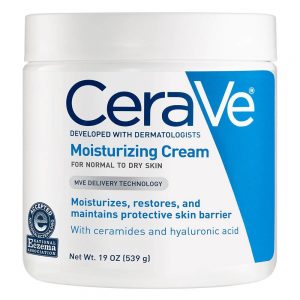 |
|
Check price | |
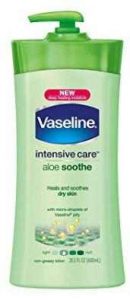 |
|
Check price | |
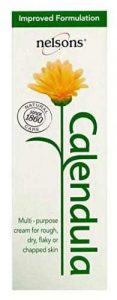 |
|
Check price |
When to see a doctor
Although most white spots will clear away on their own, those that last longer than a few weeks are a cause for concern.
Also, when other symptoms accompany the spots, you should see your doctor right away.


